Project Management on Developing a Roller Coaster: Final Report
VerifiedAdded on 2023/01/11
|15
|2690
|39
Report
AI Summary
This report details the project management aspects of developing a new roller coaster. It begins with a self-assessment of project management strengths and weaknesses. Part B outlines the project, covering traditional, Agile, xPM, and MPx considerations. It explores the five stages of the Project Management Life Cycle (PMLC), project planning, risk management, stakeholder management, and project closure, including the transfer of learning. The report includes a Gantt chart and a Network Analysis chart for project visualization and concludes with references. The assignment aims to create a thrilling roller coaster experience, providing business value and a unique feature to differentiate from competitors.
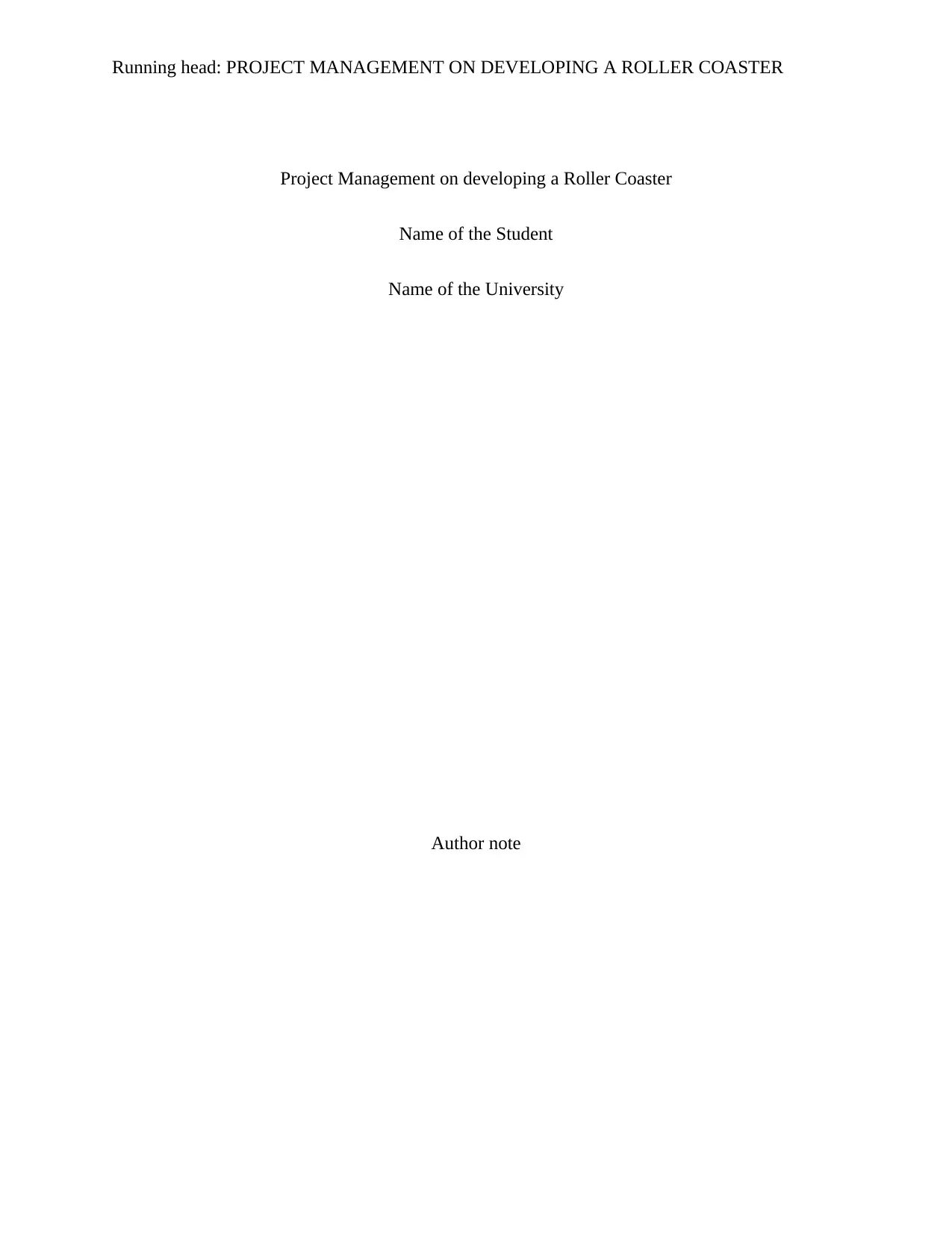
Running head: PROJECT MANAGEMENT ON DEVELOPING A ROLLER COASTER
Project Management on developing a Roller Coaster
Name of the Student
Name of the University
Author note
Project Management on developing a Roller Coaster
Name of the Student
Name of the University
Author note
Paraphrase This Document
Need a fresh take? Get an instant paraphrase of this document with our AI Paraphraser
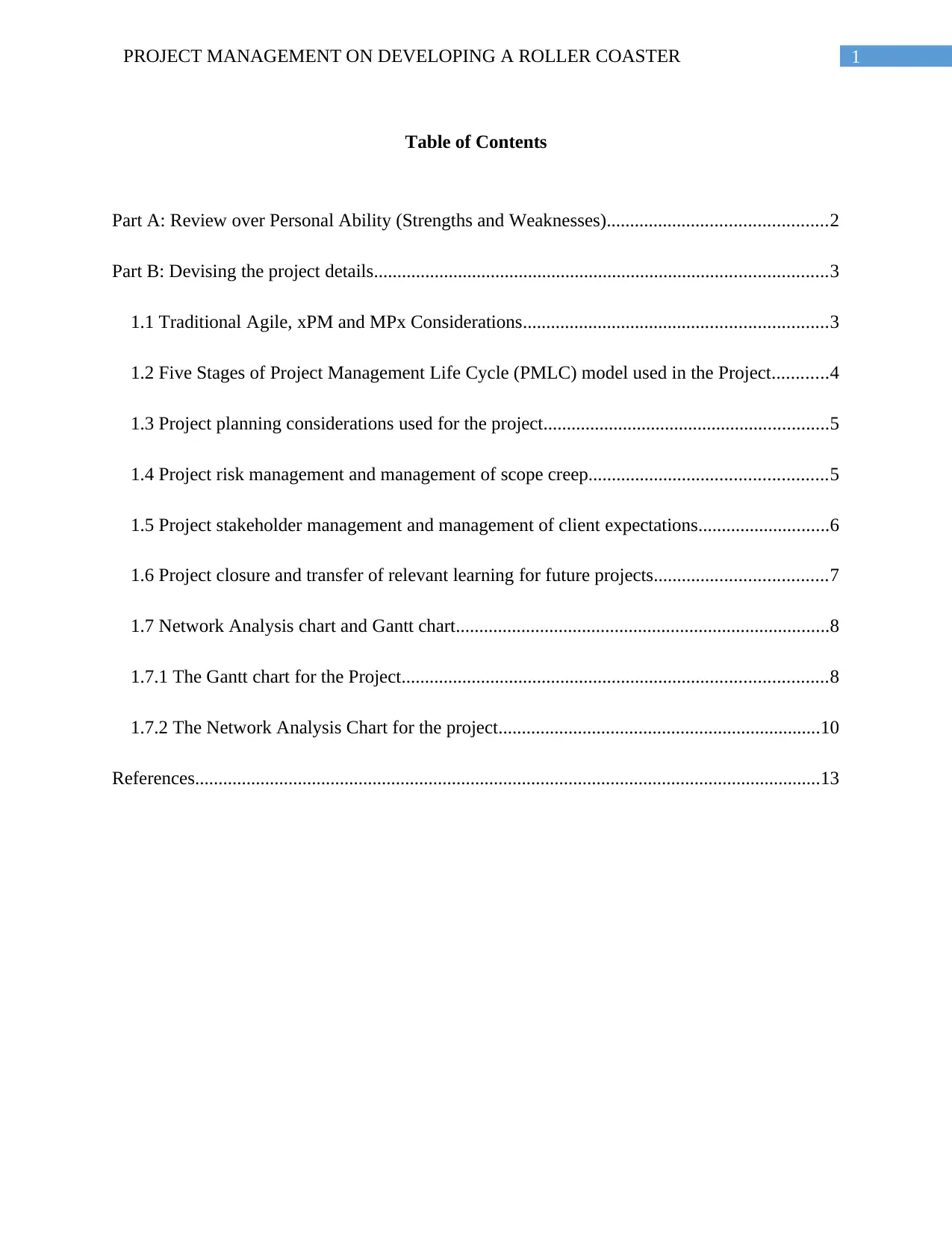
1PROJECT MANAGEMENT ON DEVELOPING A ROLLER COASTER
Table of Contents
Part A: Review over Personal Ability (Strengths and Weaknesses)...............................................2
Part B: Devising the project details.................................................................................................3
1.1 Traditional Agile, xPM and MPx Considerations.................................................................3
1.2 Five Stages of Project Management Life Cycle (PMLC) model used in the Project............4
1.3 Project planning considerations used for the project.............................................................5
1.4 Project risk management and management of scope creep...................................................5
1.5 Project stakeholder management and management of client expectations............................6
1.6 Project closure and transfer of relevant learning for future projects.....................................7
1.7 Network Analysis chart and Gantt chart................................................................................8
1.7.1 The Gantt chart for the Project...........................................................................................8
1.7.2 The Network Analysis Chart for the project.....................................................................10
References......................................................................................................................................13
Table of Contents
Part A: Review over Personal Ability (Strengths and Weaknesses)...............................................2
Part B: Devising the project details.................................................................................................3
1.1 Traditional Agile, xPM and MPx Considerations.................................................................3
1.2 Five Stages of Project Management Life Cycle (PMLC) model used in the Project............4
1.3 Project planning considerations used for the project.............................................................5
1.4 Project risk management and management of scope creep...................................................5
1.5 Project stakeholder management and management of client expectations............................6
1.6 Project closure and transfer of relevant learning for future projects.....................................7
1.7 Network Analysis chart and Gantt chart................................................................................8
1.7.1 The Gantt chart for the Project...........................................................................................8
1.7.2 The Network Analysis Chart for the project.....................................................................10
References......................................................................................................................................13
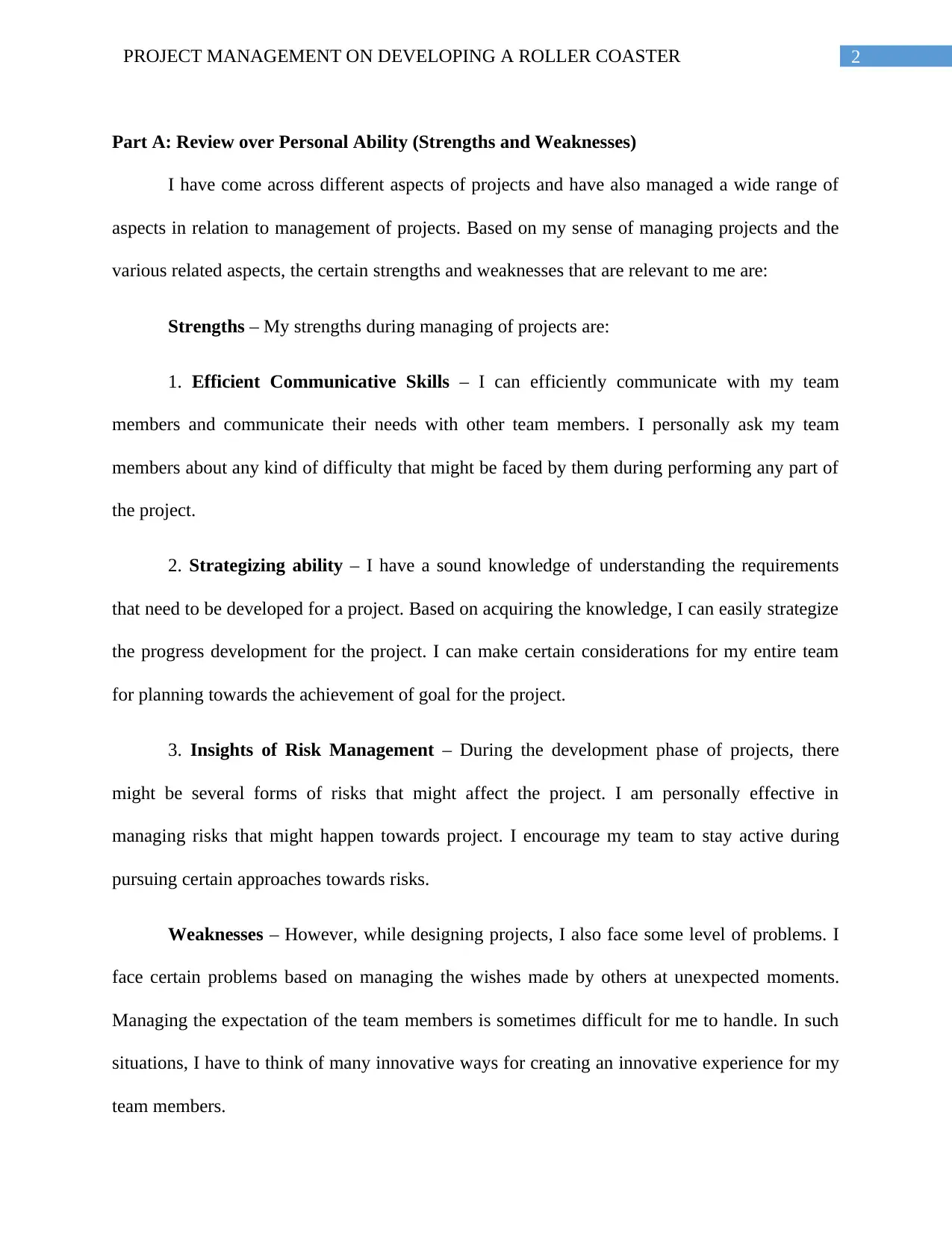
2PROJECT MANAGEMENT ON DEVELOPING A ROLLER COASTER
Part A: Review over Personal Ability (Strengths and Weaknesses)
I have come across different aspects of projects and have also managed a wide range of
aspects in relation to management of projects. Based on my sense of managing projects and the
various related aspects, the certain strengths and weaknesses that are relevant to me are:
Strengths – My strengths during managing of projects are:
1. Efficient Communicative Skills – I can efficiently communicate with my team
members and communicate their needs with other team members. I personally ask my team
members about any kind of difficulty that might be faced by them during performing any part of
the project.
2. Strategizing ability – I have a sound knowledge of understanding the requirements
that need to be developed for a project. Based on acquiring the knowledge, I can easily strategize
the progress development for the project. I can make certain considerations for my entire team
for planning towards the achievement of goal for the project.
3. Insights of Risk Management – During the development phase of projects, there
might be several forms of risks that might affect the project. I am personally effective in
managing risks that might happen towards project. I encourage my team to stay active during
pursuing certain approaches towards risks.
Weaknesses – However, while designing projects, I also face some level of problems. I
face certain problems based on managing the wishes made by others at unexpected moments.
Managing the expectation of the team members is sometimes difficult for me to handle. In such
situations, I have to think of many innovative ways for creating an innovative experience for my
team members.
Part A: Review over Personal Ability (Strengths and Weaknesses)
I have come across different aspects of projects and have also managed a wide range of
aspects in relation to management of projects. Based on my sense of managing projects and the
various related aspects, the certain strengths and weaknesses that are relevant to me are:
Strengths – My strengths during managing of projects are:
1. Efficient Communicative Skills – I can efficiently communicate with my team
members and communicate their needs with other team members. I personally ask my team
members about any kind of difficulty that might be faced by them during performing any part of
the project.
2. Strategizing ability – I have a sound knowledge of understanding the requirements
that need to be developed for a project. Based on acquiring the knowledge, I can easily strategize
the progress development for the project. I can make certain considerations for my entire team
for planning towards the achievement of goal for the project.
3. Insights of Risk Management – During the development phase of projects, there
might be several forms of risks that might affect the project. I am personally effective in
managing risks that might happen towards project. I encourage my team to stay active during
pursuing certain approaches towards risks.
Weaknesses – However, while designing projects, I also face some level of problems. I
face certain problems based on managing the wishes made by others at unexpected moments.
Managing the expectation of the team members is sometimes difficult for me to handle. In such
situations, I have to think of many innovative ways for creating an innovative experience for my
team members.
⊘ This is a preview!⊘
Do you want full access?
Subscribe today to unlock all pages.

Trusted by 1+ million students worldwide
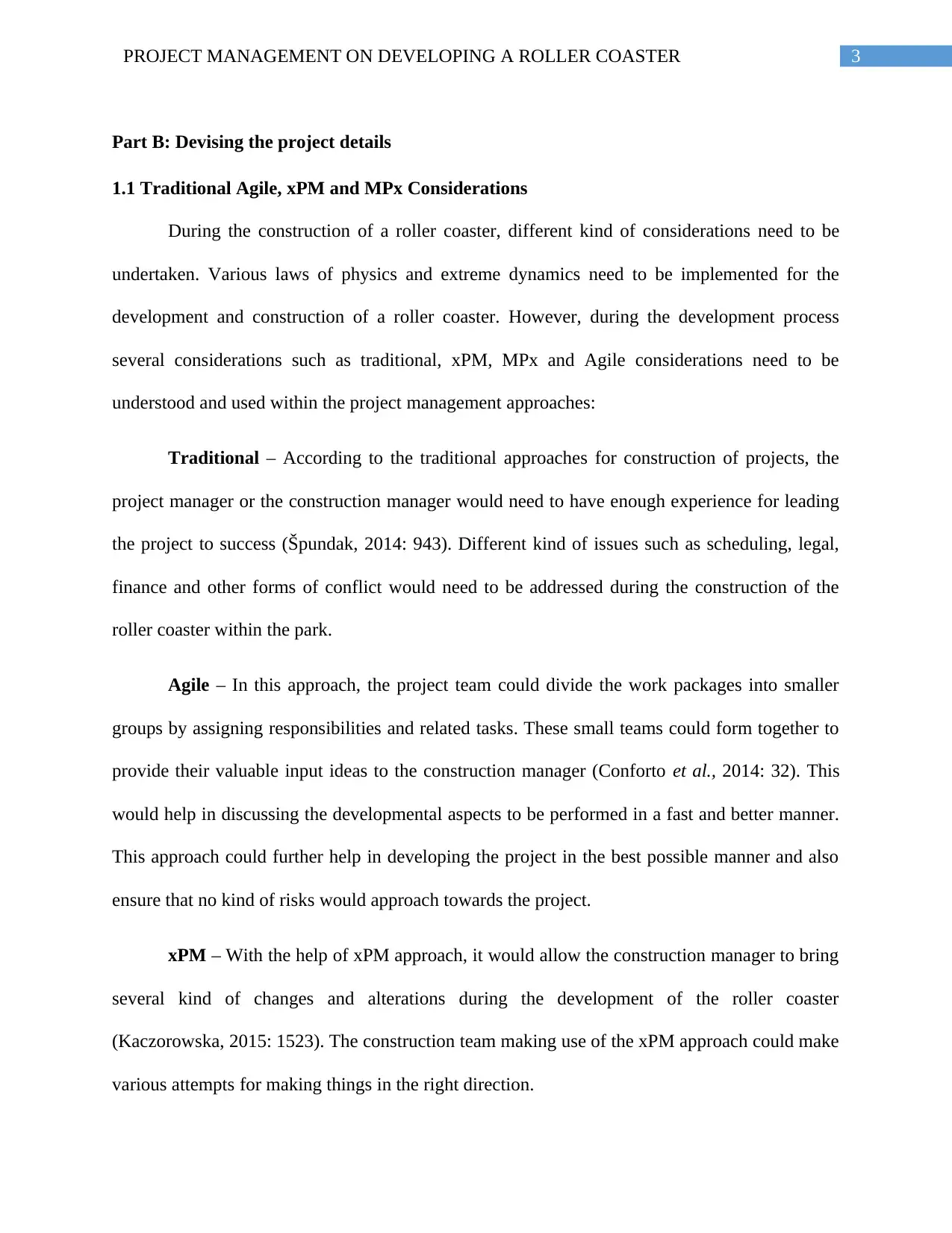
3PROJECT MANAGEMENT ON DEVELOPING A ROLLER COASTER
Part B: Devising the project details
1.1 Traditional Agile, xPM and MPx Considerations
During the construction of a roller coaster, different kind of considerations need to be
undertaken. Various laws of physics and extreme dynamics need to be implemented for the
development and construction of a roller coaster. However, during the development process
several considerations such as traditional, xPM, MPx and Agile considerations need to be
understood and used within the project management approaches:
Traditional – According to the traditional approaches for construction of projects, the
project manager or the construction manager would need to have enough experience for leading
the project to success (Špundak, 2014: 943). Different kind of issues such as scheduling, legal,
finance and other forms of conflict would need to be addressed during the construction of the
roller coaster within the park.
Agile – In this approach, the project team could divide the work packages into smaller
groups by assigning responsibilities and related tasks. These small teams could form together to
provide their valuable input ideas to the construction manager (Conforto et al., 2014: 32). This
would help in discussing the developmental aspects to be performed in a fast and better manner.
This approach could further help in developing the project in the best possible manner and also
ensure that no kind of risks would approach towards the project.
xPM – With the help of xPM approach, it would allow the construction manager to bring
several kind of changes and alterations during the development of the roller coaster
(Kaczorowska, 2015: 1523). The construction team making use of the xPM approach could make
various attempts for making things in the right direction.
Part B: Devising the project details
1.1 Traditional Agile, xPM and MPx Considerations
During the construction of a roller coaster, different kind of considerations need to be
undertaken. Various laws of physics and extreme dynamics need to be implemented for the
development and construction of a roller coaster. However, during the development process
several considerations such as traditional, xPM, MPx and Agile considerations need to be
understood and used within the project management approaches:
Traditional – According to the traditional approaches for construction of projects, the
project manager or the construction manager would need to have enough experience for leading
the project to success (Špundak, 2014: 943). Different kind of issues such as scheduling, legal,
finance and other forms of conflict would need to be addressed during the construction of the
roller coaster within the park.
Agile – In this approach, the project team could divide the work packages into smaller
groups by assigning responsibilities and related tasks. These small teams could form together to
provide their valuable input ideas to the construction manager (Conforto et al., 2014: 32). This
would help in discussing the developmental aspects to be performed in a fast and better manner.
This approach could further help in developing the project in the best possible manner and also
ensure that no kind of risks would approach towards the project.
xPM – With the help of xPM approach, it would allow the construction manager to bring
several kind of changes and alterations during the development of the roller coaster
(Kaczorowska, 2015: 1523). The construction team making use of the xPM approach could make
various attempts for making things in the right direction.
Paraphrase This Document
Need a fresh take? Get an instant paraphrase of this document with our AI Paraphraser
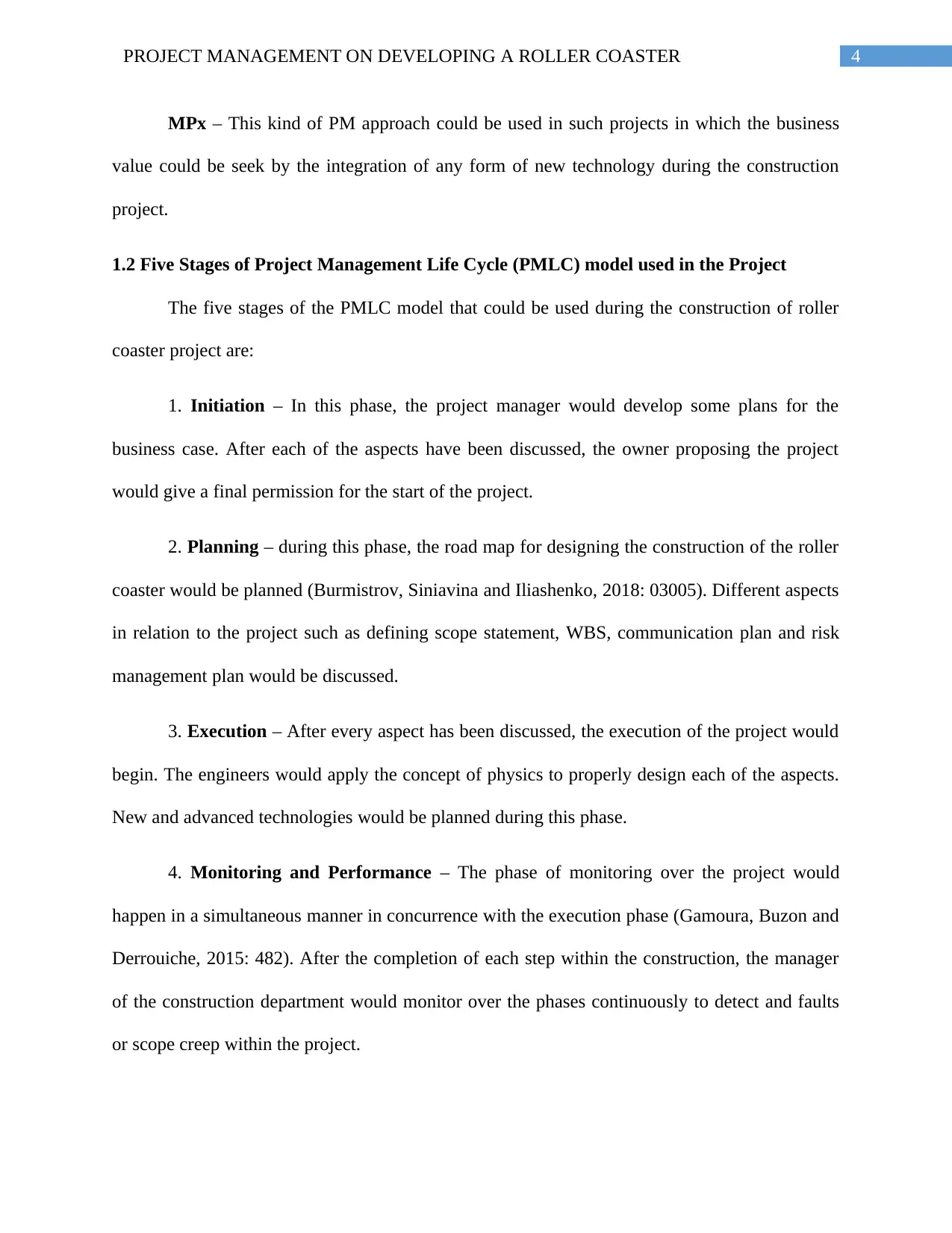
4PROJECT MANAGEMENT ON DEVELOPING A ROLLER COASTER
MPx – This kind of PM approach could be used in such projects in which the business
value could be seek by the integration of any form of new technology during the construction
project.
1.2 Five Stages of Project Management Life Cycle (PMLC) model used in the Project
The five stages of the PMLC model that could be used during the construction of roller
coaster project are:
1. Initiation – In this phase, the project manager would develop some plans for the
business case. After each of the aspects have been discussed, the owner proposing the project
would give a final permission for the start of the project.
2. Planning – during this phase, the road map for designing the construction of the roller
coaster would be planned (Burmistrov, Siniavina and Iliashenko, 2018: 03005). Different aspects
in relation to the project such as defining scope statement, WBS, communication plan and risk
management plan would be discussed.
3. Execution – After every aspect has been discussed, the execution of the project would
begin. The engineers would apply the concept of physics to properly design each of the aspects.
New and advanced technologies would be planned during this phase.
4. Monitoring and Performance – The phase of monitoring over the project would
happen in a simultaneous manner in concurrence with the execution phase (Gamoura, Buzon and
Derrouiche, 2015: 482). After the completion of each step within the construction, the manager
of the construction department would monitor over the phases continuously to detect and faults
or scope creep within the project.
MPx – This kind of PM approach could be used in such projects in which the business
value could be seek by the integration of any form of new technology during the construction
project.
1.2 Five Stages of Project Management Life Cycle (PMLC) model used in the Project
The five stages of the PMLC model that could be used during the construction of roller
coaster project are:
1. Initiation – In this phase, the project manager would develop some plans for the
business case. After each of the aspects have been discussed, the owner proposing the project
would give a final permission for the start of the project.
2. Planning – during this phase, the road map for designing the construction of the roller
coaster would be planned (Burmistrov, Siniavina and Iliashenko, 2018: 03005). Different aspects
in relation to the project such as defining scope statement, WBS, communication plan and risk
management plan would be discussed.
3. Execution – After every aspect has been discussed, the execution of the project would
begin. The engineers would apply the concept of physics to properly design each of the aspects.
New and advanced technologies would be planned during this phase.
4. Monitoring and Performance – The phase of monitoring over the project would
happen in a simultaneous manner in concurrence with the execution phase (Gamoura, Buzon and
Derrouiche, 2015: 482). After the completion of each step within the construction, the manager
of the construction department would monitor over the phases continuously to detect and faults
or scope creep within the project.
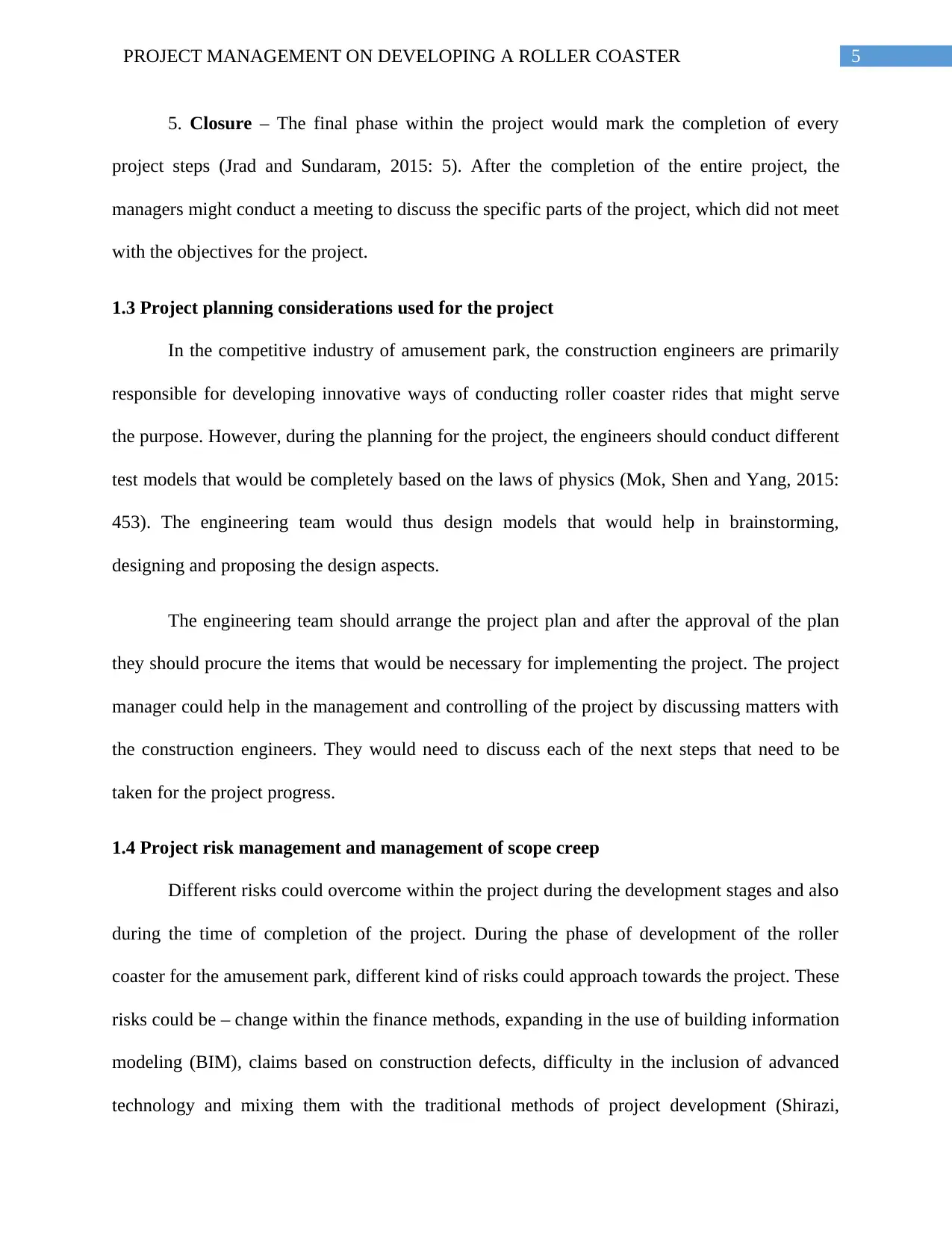
5PROJECT MANAGEMENT ON DEVELOPING A ROLLER COASTER
5. Closure – The final phase within the project would mark the completion of every
project steps (Jrad and Sundaram, 2015: 5). After the completion of the entire project, the
managers might conduct a meeting to discuss the specific parts of the project, which did not meet
with the objectives for the project.
1.3 Project planning considerations used for the project
In the competitive industry of amusement park, the construction engineers are primarily
responsible for developing innovative ways of conducting roller coaster rides that might serve
the purpose. However, during the planning for the project, the engineers should conduct different
test models that would be completely based on the laws of physics (Mok, Shen and Yang, 2015:
453). The engineering team would thus design models that would help in brainstorming,
designing and proposing the design aspects.
The engineering team should arrange the project plan and after the approval of the plan
they should procure the items that would be necessary for implementing the project. The project
manager could help in the management and controlling of the project by discussing matters with
the construction engineers. They would need to discuss each of the next steps that need to be
taken for the project progress.
1.4 Project risk management and management of scope creep
Different risks could overcome within the project during the development stages and also
during the time of completion of the project. During the phase of development of the roller
coaster for the amusement park, different kind of risks could approach towards the project. These
risks could be – change within the finance methods, expanding in the use of building information
modeling (BIM), claims based on construction defects, difficulty in the inclusion of advanced
technology and mixing them with the traditional methods of project development (Shirazi,
5. Closure – The final phase within the project would mark the completion of every
project steps (Jrad and Sundaram, 2015: 5). After the completion of the entire project, the
managers might conduct a meeting to discuss the specific parts of the project, which did not meet
with the objectives for the project.
1.3 Project planning considerations used for the project
In the competitive industry of amusement park, the construction engineers are primarily
responsible for developing innovative ways of conducting roller coaster rides that might serve
the purpose. However, during the planning for the project, the engineers should conduct different
test models that would be completely based on the laws of physics (Mok, Shen and Yang, 2015:
453). The engineering team would thus design models that would help in brainstorming,
designing and proposing the design aspects.
The engineering team should arrange the project plan and after the approval of the plan
they should procure the items that would be necessary for implementing the project. The project
manager could help in the management and controlling of the project by discussing matters with
the construction engineers. They would need to discuss each of the next steps that need to be
taken for the project progress.
1.4 Project risk management and management of scope creep
Different risks could overcome within the project during the development stages and also
during the time of completion of the project. During the phase of development of the roller
coaster for the amusement park, different kind of risks could approach towards the project. These
risks could be – change within the finance methods, expanding in the use of building information
modeling (BIM), claims based on construction defects, difficulty in the inclusion of advanced
technology and mixing them with the traditional methods of project development (Shirazi,
⊘ This is a preview!⊘
Do you want full access?
Subscribe today to unlock all pages.

Trusted by 1+ million students worldwide
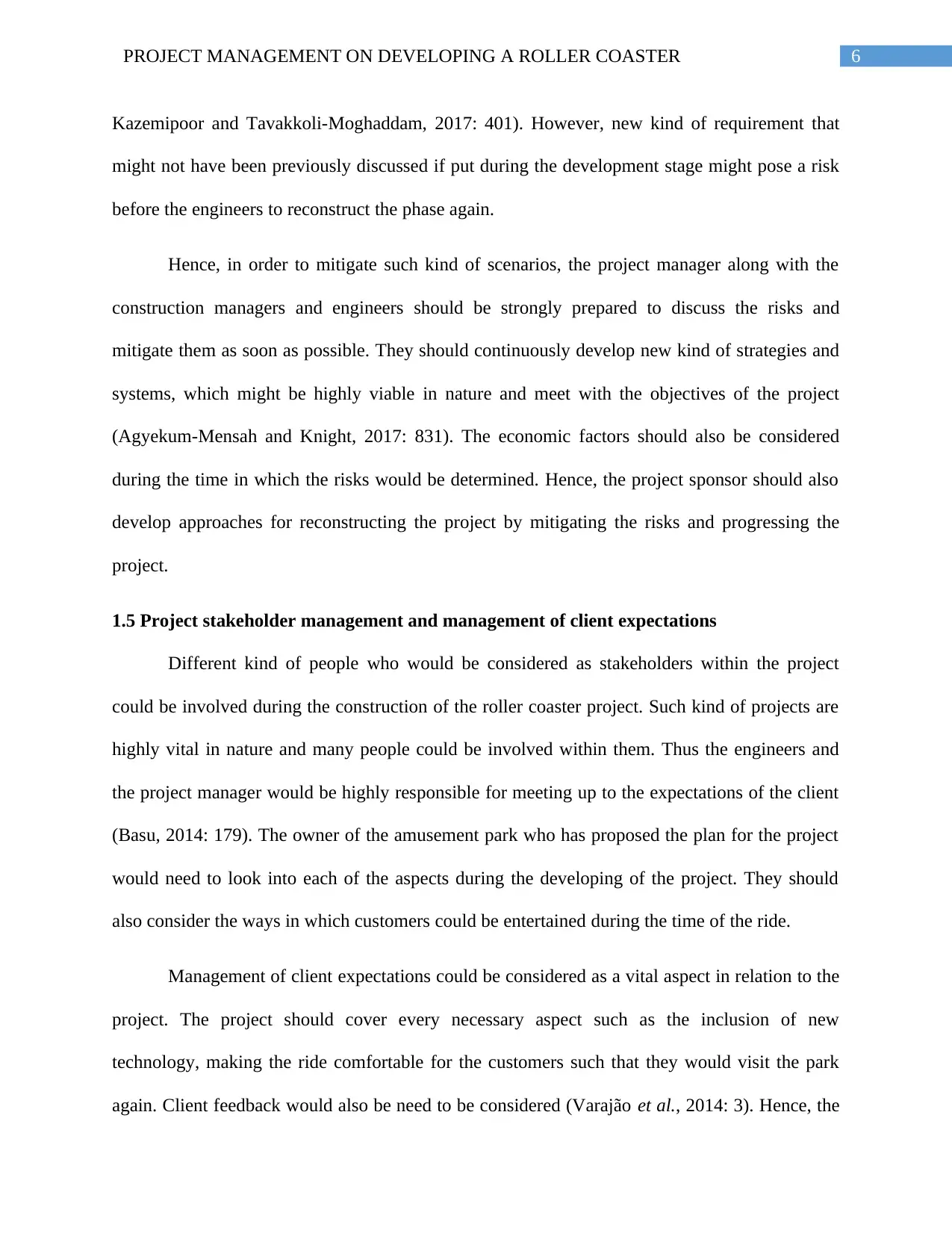
6PROJECT MANAGEMENT ON DEVELOPING A ROLLER COASTER
Kazemipoor and Tavakkoli-Moghaddam, 2017: 401). However, new kind of requirement that
might not have been previously discussed if put during the development stage might pose a risk
before the engineers to reconstruct the phase again.
Hence, in order to mitigate such kind of scenarios, the project manager along with the
construction managers and engineers should be strongly prepared to discuss the risks and
mitigate them as soon as possible. They should continuously develop new kind of strategies and
systems, which might be highly viable in nature and meet with the objectives of the project
(Agyekum-Mensah and Knight, 2017: 831). The economic factors should also be considered
during the time in which the risks would be determined. Hence, the project sponsor should also
develop approaches for reconstructing the project by mitigating the risks and progressing the
project.
1.5 Project stakeholder management and management of client expectations
Different kind of people who would be considered as stakeholders within the project
could be involved during the construction of the roller coaster project. Such kind of projects are
highly vital in nature and many people could be involved within them. Thus the engineers and
the project manager would be highly responsible for meeting up to the expectations of the client
(Basu, 2014: 179). The owner of the amusement park who has proposed the plan for the project
would need to look into each of the aspects during the developing of the project. They should
also consider the ways in which customers could be entertained during the time of the ride.
Management of client expectations could be considered as a vital aspect in relation to the
project. The project should cover every necessary aspect such as the inclusion of new
technology, making the ride comfortable for the customers such that they would visit the park
again. Client feedback would also be need to be considered (Varajão et al., 2014: 3). Hence, the
Kazemipoor and Tavakkoli-Moghaddam, 2017: 401). However, new kind of requirement that
might not have been previously discussed if put during the development stage might pose a risk
before the engineers to reconstruct the phase again.
Hence, in order to mitigate such kind of scenarios, the project manager along with the
construction managers and engineers should be strongly prepared to discuss the risks and
mitigate them as soon as possible. They should continuously develop new kind of strategies and
systems, which might be highly viable in nature and meet with the objectives of the project
(Agyekum-Mensah and Knight, 2017: 831). The economic factors should also be considered
during the time in which the risks would be determined. Hence, the project sponsor should also
develop approaches for reconstructing the project by mitigating the risks and progressing the
project.
1.5 Project stakeholder management and management of client expectations
Different kind of people who would be considered as stakeholders within the project
could be involved during the construction of the roller coaster project. Such kind of projects are
highly vital in nature and many people could be involved within them. Thus the engineers and
the project manager would be highly responsible for meeting up to the expectations of the client
(Basu, 2014: 179). The owner of the amusement park who has proposed the plan for the project
would need to look into each of the aspects during the developing of the project. They should
also consider the ways in which customers could be entertained during the time of the ride.
Management of client expectations could be considered as a vital aspect in relation to the
project. The project should cover every necessary aspect such as the inclusion of new
technology, making the ride comfortable for the customers such that they would visit the park
again. Client feedback would also be need to be considered (Varajão et al., 2014: 3). Hence, the
Paraphrase This Document
Need a fresh take? Get an instant paraphrase of this document with our AI Paraphraser
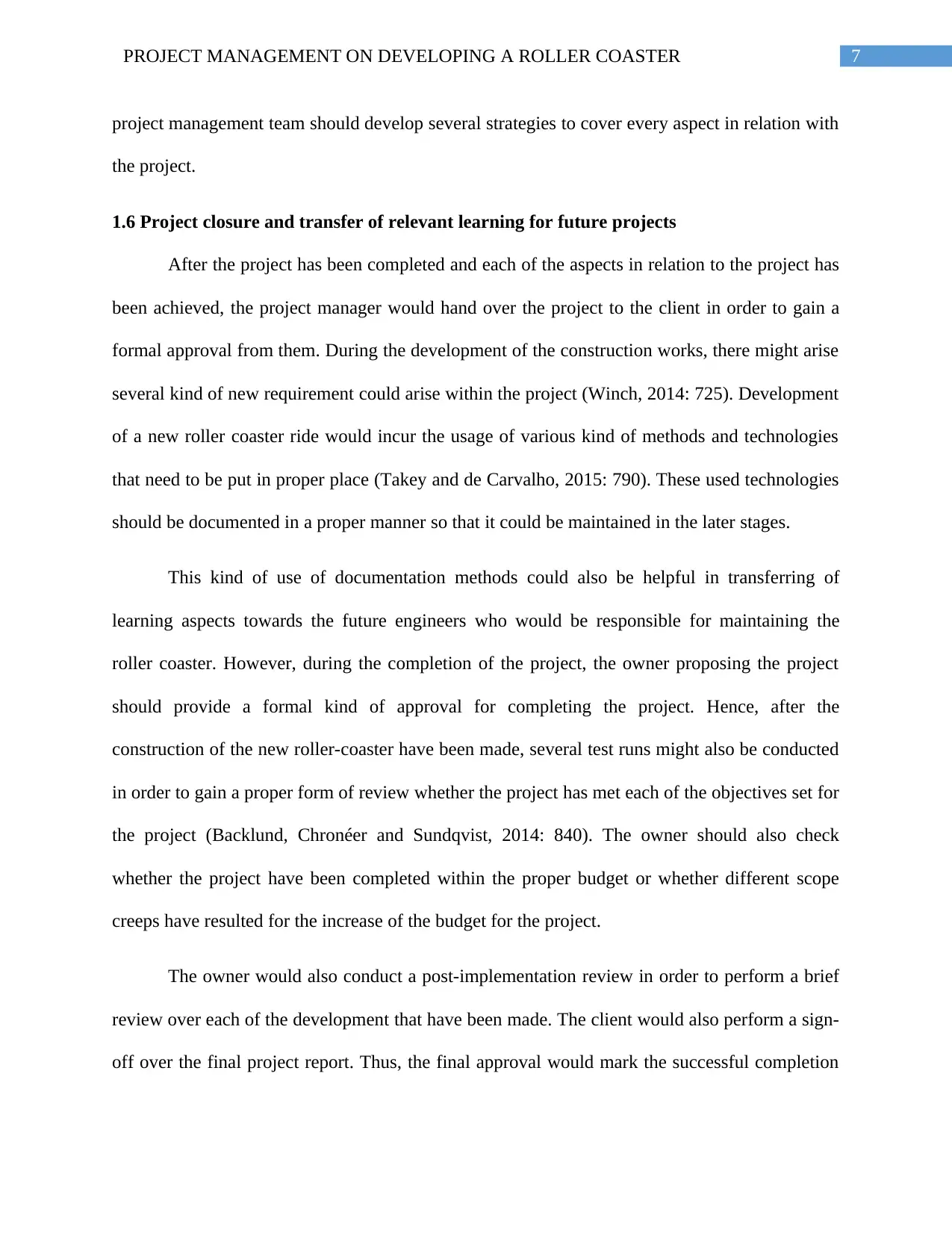
7PROJECT MANAGEMENT ON DEVELOPING A ROLLER COASTER
project management team should develop several strategies to cover every aspect in relation with
the project.
1.6 Project closure and transfer of relevant learning for future projects
After the project has been completed and each of the aspects in relation to the project has
been achieved, the project manager would hand over the project to the client in order to gain a
formal approval from them. During the development of the construction works, there might arise
several kind of new requirement could arise within the project (Winch, 2014: 725). Development
of a new roller coaster ride would incur the usage of various kind of methods and technologies
that need to be put in proper place (Takey and de Carvalho, 2015: 790). These used technologies
should be documented in a proper manner so that it could be maintained in the later stages.
This kind of use of documentation methods could also be helpful in transferring of
learning aspects towards the future engineers who would be responsible for maintaining the
roller coaster. However, during the completion of the project, the owner proposing the project
should provide a formal kind of approval for completing the project. Hence, after the
construction of the new roller-coaster have been made, several test runs might also be conducted
in order to gain a proper form of review whether the project has met each of the objectives set for
the project (Backlund, Chronéer and Sundqvist, 2014: 840). The owner should also check
whether the project have been completed within the proper budget or whether different scope
creeps have resulted for the increase of the budget for the project.
The owner would also conduct a post-implementation review in order to perform a brief
review over each of the development that have been made. The client would also perform a sign-
off over the final project report. Thus, the final approval would mark the successful completion
project management team should develop several strategies to cover every aspect in relation with
the project.
1.6 Project closure and transfer of relevant learning for future projects
After the project has been completed and each of the aspects in relation to the project has
been achieved, the project manager would hand over the project to the client in order to gain a
formal approval from them. During the development of the construction works, there might arise
several kind of new requirement could arise within the project (Winch, 2014: 725). Development
of a new roller coaster ride would incur the usage of various kind of methods and technologies
that need to be put in proper place (Takey and de Carvalho, 2015: 790). These used technologies
should be documented in a proper manner so that it could be maintained in the later stages.
This kind of use of documentation methods could also be helpful in transferring of
learning aspects towards the future engineers who would be responsible for maintaining the
roller coaster. However, during the completion of the project, the owner proposing the project
should provide a formal kind of approval for completing the project. Hence, after the
construction of the new roller-coaster have been made, several test runs might also be conducted
in order to gain a proper form of review whether the project has met each of the objectives set for
the project (Backlund, Chronéer and Sundqvist, 2014: 840). The owner should also check
whether the project have been completed within the proper budget or whether different scope
creeps have resulted for the increase of the budget for the project.
The owner would also conduct a post-implementation review in order to perform a brief
review over each of the development that have been made. The client would also perform a sign-
off over the final project report. Thus, the final approval would mark the successful completion
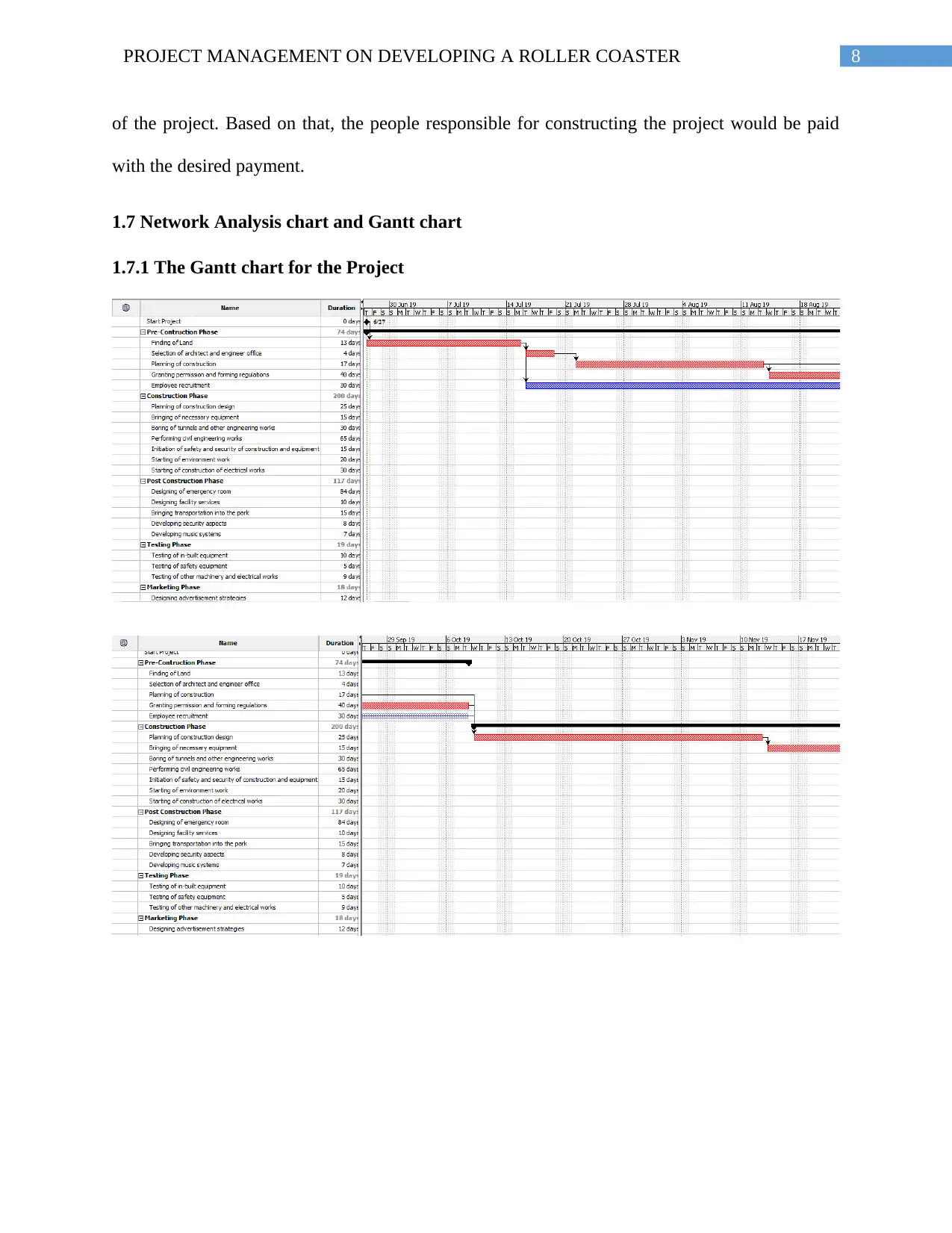
8PROJECT MANAGEMENT ON DEVELOPING A ROLLER COASTER
of the project. Based on that, the people responsible for constructing the project would be paid
with the desired payment.
1.7 Network Analysis chart and Gantt chart
1.7.1 The Gantt chart for the Project
of the project. Based on that, the people responsible for constructing the project would be paid
with the desired payment.
1.7 Network Analysis chart and Gantt chart
1.7.1 The Gantt chart for the Project
⊘ This is a preview!⊘
Do you want full access?
Subscribe today to unlock all pages.

Trusted by 1+ million students worldwide
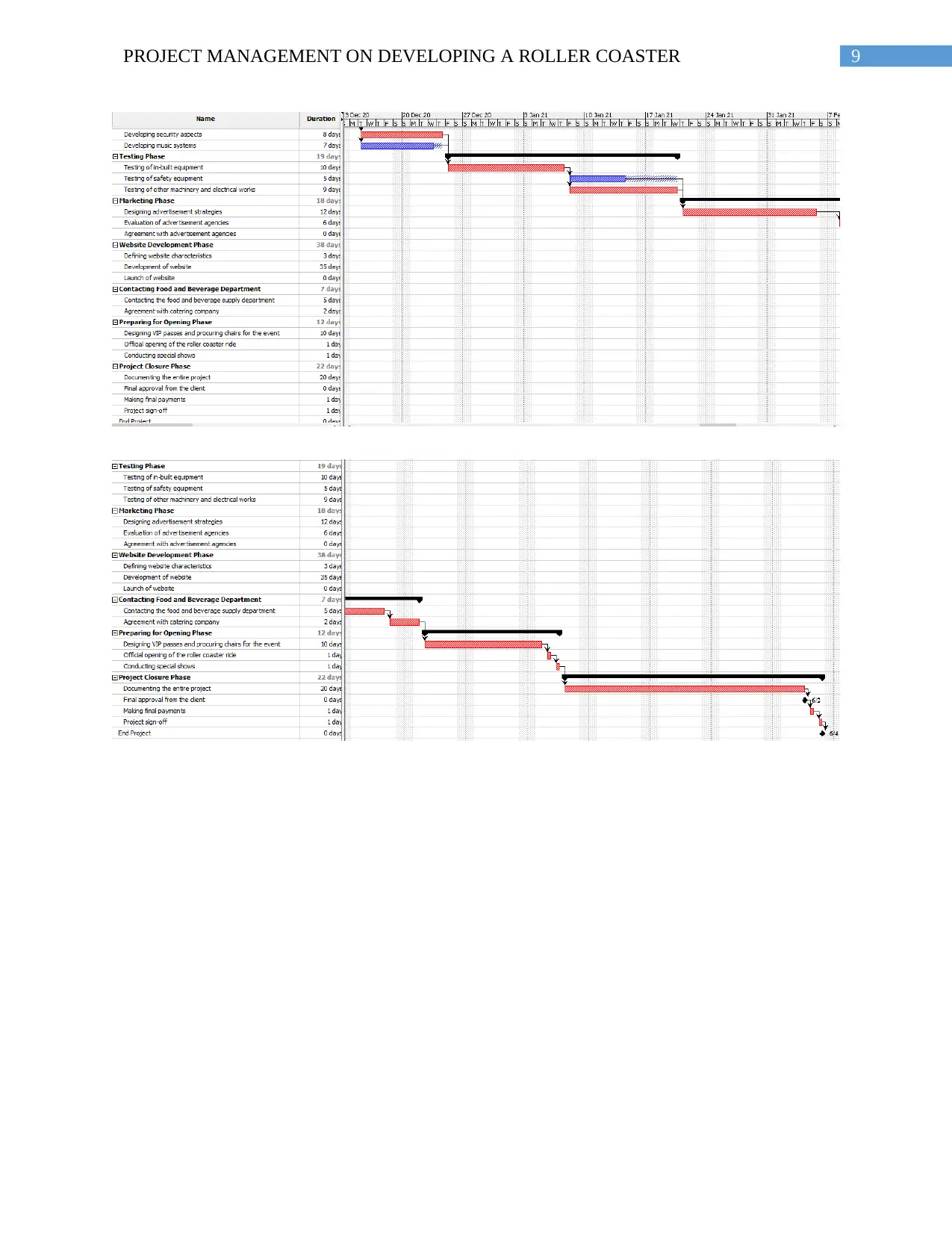
9PROJECT MANAGEMENT ON DEVELOPING A ROLLER COASTER
Paraphrase This Document
Need a fresh take? Get an instant paraphrase of this document with our AI Paraphraser
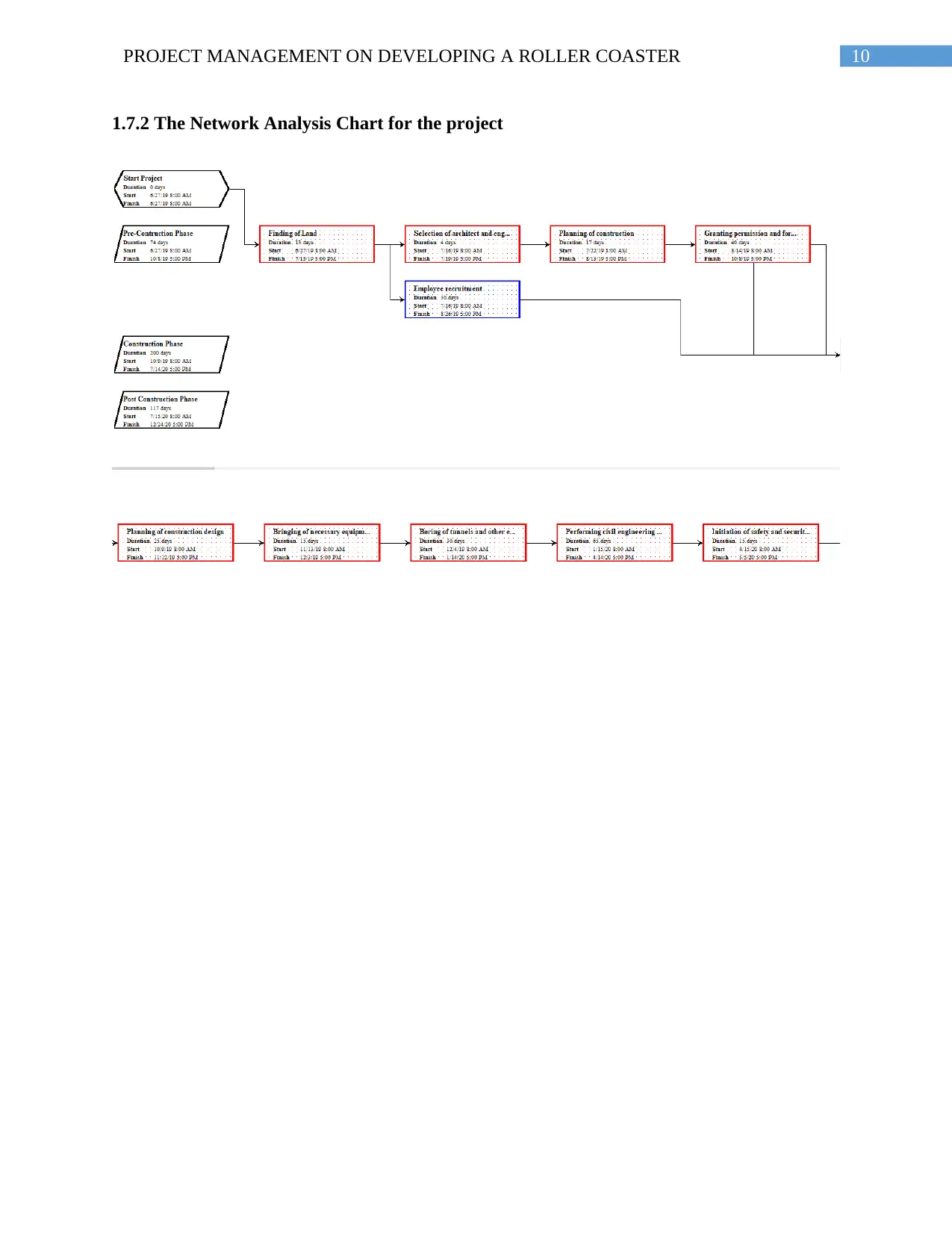
10PROJECT MANAGEMENT ON DEVELOPING A ROLLER COASTER
1.7.2 The Network Analysis Chart for the project
1.7.2 The Network Analysis Chart for the project
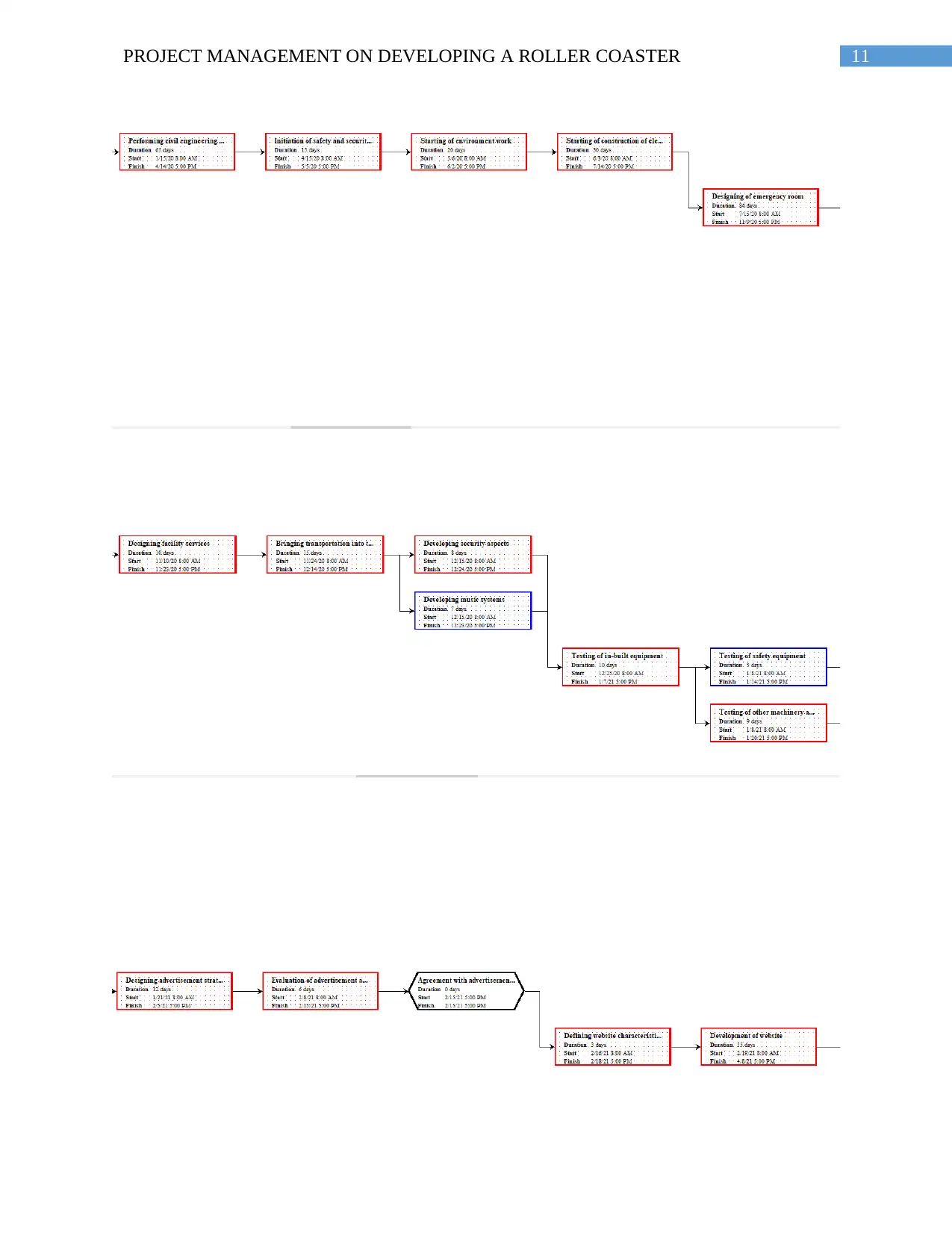
11PROJECT MANAGEMENT ON DEVELOPING A ROLLER COASTER
⊘ This is a preview!⊘
Do you want full access?
Subscribe today to unlock all pages.

Trusted by 1+ million students worldwide
1 out of 15
Related Documents
Your All-in-One AI-Powered Toolkit for Academic Success.
+13062052269
info@desklib.com
Available 24*7 on WhatsApp / Email
![[object Object]](/_next/static/media/star-bottom.7253800d.svg)
Unlock your academic potential
Copyright © 2020–2025 A2Z Services. All Rights Reserved. Developed and managed by ZUCOL.





